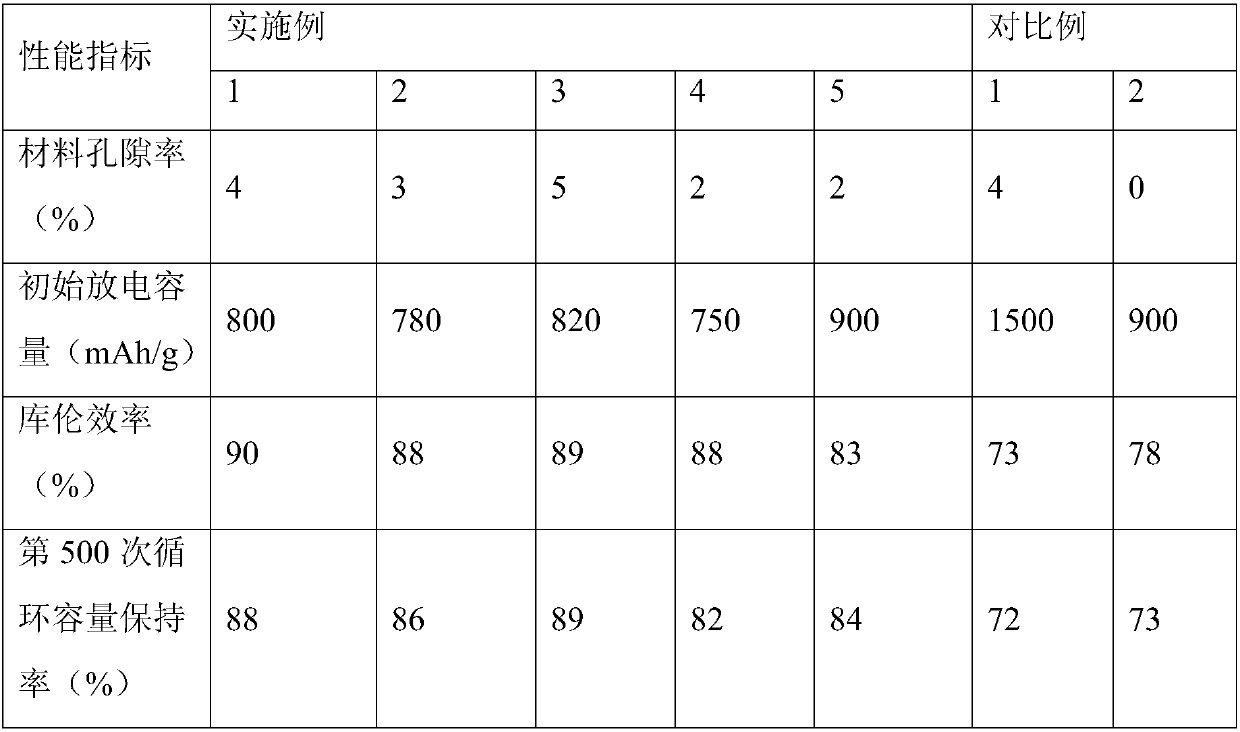Negative electrode composite material of lithium ion battery and preparation method thereof
A lithium-ion battery and composite material technology, which is applied in the field of lithium-ion battery negative electrode composite materials and its preparation, can solve problems such as poor cycle stability, electrode powdering, and damage to the coating layer, and achieve powdering prevention, simple process, and improved The effect of cycle stability
- Summary
- Abstract
- Description
- Claims
- Application Information
AI Technical Summary
Problems solved by technology
Method used
Image
Examples
Embodiment 1
[0050] (1) Add 500g of methyltrimethoxysilane to a 20Kg aqueous solution containing 20g of HEC, 80g of PVA and 50g of DISPEBYK-2012, stir and react for 10min, add 1Kg (D50 is 50-100nm) nano silicon powder, stir for 30min, and control the temperature at 60 ℃. Nitric acid was added dropwise, the pH was controlled at 3 to 4, and the reaction was allowed to stand at room temperature (25°C) for 2 hours to obtain the intermediate (Si / SiO x ), D50=800nm.
[0051] (2) 1Kg of graphite with D50=10um was added to the suspension system and stirred for 1 hour, then spray-dried. The inlet temperature of the spray dryer was set at 300°C, and the outlet temperature was set at 120°C to obtain spherical materials.
[0052] (3) Redox reaction and carbonization treatment are carried out on the above-mentioned spherical material in a carbonization furnace under an argon atmosphere, the temperature is set at 1200° C., and the temperature is kept for 4 hours.
Embodiment 2
[0054] (1) Add 400g of methyltrimethoxysilane to a 20Kg aqueous solution containing 10g of HEC, 40g of PVA and 30g of DISPEBYK-2012, stir and react for 10min, add 1Kg (D50 is 50-100nm) nano silicon powder, stir for 30min, and control the temperature at 60 ℃. Nitric acid was added dropwise, the pH was controlled at 3 to 4, and the reaction was allowed to stand at room temperature (25°C) for 2 hours to obtain the intermediate (Si / SiO x ), D50=600nm.
[0055] (2) 1Kg D50=10um graphite was added to the suspension system and stirred for 1 hour, then spray-dried. The inlet temperature of the spray dryer was set at 280°C, and the outlet temperature was set at 110°C to obtain spherical materials.
[0056] (3) Redox reaction and carbonization treatment are carried out on the above-mentioned spherical material in a carbonization furnace under an argon atmosphere, the temperature is set at 1200° C., and the temperature is kept for 4 hours.
Embodiment 3
[0058] (1) Add 600g of methyltrimethoxysilane to a 20Kg aqueous solution containing 20g of HEC, 80g of PVA and 30g of DISPEBYK-2012, stir and react for 10min, add 1Kg (D50 is 50-100nm) nano silicon powder, stir for 30min, and control the temperature at 60 ℃. Nitric acid was added dropwise, the pH was controlled at 3 to 4, and the reaction was allowed to stand at room temperature (25°C) for 2 hours to obtain the intermediate (Si / SiO x ), D50=1um.
[0059] (2) 900g of graphite with D50=1um was added to the suspension system and stirred for 1h, then spray-dried, the inlet temperature of the spray dryer was set at 280°C, and the outlet temperature was set at 100°C to obtain spherical materials.
[0060] (3) Redox reaction and carbonization treatment are carried out on the above-mentioned spherical material in a carbonization furnace under an argon atmosphere, the temperature is set at 1000° C., and the temperature is kept for 8 hours to obtain the product.
PUM
| Property | Measurement | Unit |
|---|---|---|
| particle diameter | aaaaa | aaaaa |
| particle diameter | aaaaa | aaaaa |
| porosity | aaaaa | aaaaa |
Abstract
Description
Claims
Application Information
 Login to View More
Login to View More - R&D
- Intellectual Property
- Life Sciences
- Materials
- Tech Scout
- Unparalleled Data Quality
- Higher Quality Content
- 60% Fewer Hallucinations
Browse by: Latest US Patents, China's latest patents, Technical Efficacy Thesaurus, Application Domain, Technology Topic, Popular Technical Reports.
© 2025 PatSnap. All rights reserved.Legal|Privacy policy|Modern Slavery Act Transparency Statement|Sitemap|About US| Contact US: help@patsnap.com


